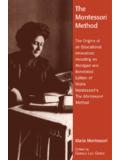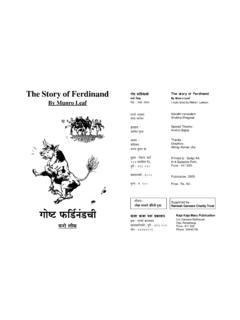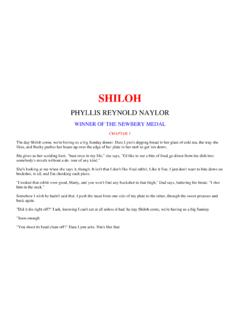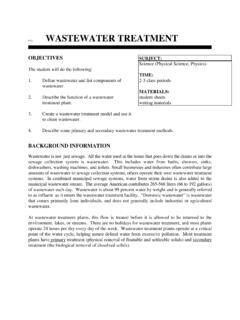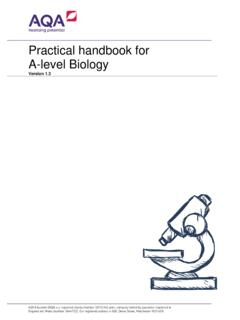Transcription of 700 SCIENCE EXPERIMENTS FOR EVERYONE COMPILED BY …
1 700 SCIENCE EXPERIMENTS FOR EVERYONECOMPILED BY UNESCO Would you like to create a cloud in a bottle? Prove that the earth spins? Run a telephone nextdoor? Keep a thriving ant colony? Weigh the atmosphere? Make your own soap? Identifyfossils? These are only a few of the more than 700 simple, safe, and exciting EXPERIMENTS that will helpyou to discover and understand many fascinating, scientific facts about the wonderful world inwhich we live. Some of these projects will take you no more than a single morning; others willkeep you and your friends busy for months, at home or at school. COMPILED by a team of American, British, and French SCIENCE instructors under the auspices ofUNESCO in Paris, this latest edition features new sections on Optical Projection, Electricity, andChemistry, in addition to enlarged chapters on Astronomy, Magnetism, Geology, Physiology, andmany more! (continued on back flap) The United Nations Educational, Scientific, and CulturalOrganization Each chapter offers approximately 50 related EXPERIMENTS , with brief, easy- to-follow instruc-tions and clear how- to diagrams.
2 This edition also tells you exactly what materials you willneed for each experiment and where to get them. The materials are inexpensive and easy to are probably in your home or garage, and the others you can get at your neighborhoodmarket, drugstore, or hardware store. If you are curious about how things work, why they grow, how they live, and what they aremade of in other words, if you have the same everyday curiosity that motivated such scientificpioneers as Archimedes, Galileo, Newton, and Darwin 700 SCIENCE EXPERIMENTS FOREVERYONE is the book for you. For these EXPERIMENTS will not only answer practically everyquestion you might have on the natural and life sciences , they will teach you the scientific ap-proach to problems you may want to solve on your own and show you the methods for solvingthem. Above all, you will learn that the study of SCIENCE can be exciting, useful and lots of fun!IMPORTANT NOTE TO PARENTS, TEACHERS, BOYS AND GIRLS This book was originally prepared for use as an instruction manual by teachers, where a certainlevel of experience, precaution, and discretion are presumed.
3 A number of EXPERIMENTS in this book, although totally safe if properly prepared and wiselyhandled, could prove dangerous to the inexperienced or careless experimenter. Any experimentinvolving fire or explosive reactions should be approached with the greatest of caution andprotection. Be careful where you find or purchase materials so that you don t end up using defective, andtherefore dangerous, materials. Good scientists are methodical and excruciatingly careful. Please be one. In the interest of safetyseveral EXPERIMENTS published in the original edition of this book have been deleted. Introduction SCIENCE is perhaps unique as a subject in the curriculum of schools all over the world. This uniquenessresults from the variety of materials and EXPERIMENTS necessary for its effective teaching. Most other subjectscan be learned if ordinary tools are available, such as pencil, paper, blackboard, textbooks and a fewsupplementary aids.
4 These are also essential for the teaching of SCIENCE but, if they are the only tools, SCIENCE becomes a dull and uninteresting subject. If it is to be learned effectively SCIENCE must be experienced. It must be learned and not learned is so close to the life of every boy and girl that there is no need to confine its study to the reading oftextbooks or listening to lectures. Wherever you may go in the world, SCIENCE is an intimate part of theenvironment living things, the earth, the sky, air and water, heat and light and forces such as gravity. Noteacher need ever be without first-hand materials for the study of SCIENCE . Good SCIENCE teaching must be based on observation and experiment . There can be no substitute forthese. But performing EXPERIMENTS and learning to make close observations require special facilities, andthese are lacking in many parts of the world, especially at the elementary and early secondary levels.
5 As aresult, SCIENCE teaching suffers a severe handicap in these regions. It is often believed thougherroneously that to introduce laboratory teaching, even at the elementary level, requires elaborateequipment made by commercial manufacturers. Such materials are prohibitively expensive for mostelementary and early secondary teaching, and in many parts of the world are quite unobtainable becausethey are not manufactured locally and cannot be imported because of the cost. At the close of the second world war, many schools in many countries had been destroyed. As theseschools began to revive, there was a great need for SCIENCE equipment; for these countries had a tradition ofbasing SCIENCE teaching on observation and experiment . To meet this need, Unesco sponsored theproduction of a small volume entitled Suggestions for SCIENCE Teachers in Devastated Countries. This bookwas written by Mr. J. P. Stephenson ( SCIENCE master at the City of London School; member of the RoyalSociety Committee for Go-operation with Unesco, United Kingdom).
6 While it proved very useful for thedevastated areas, it has had a phenomenal success in regions where previously there had been little or noequipment. Emphasizing the making and use of equipment from simple materials, the book has filled a greatneed in those countries where teachers are just becoming aware of the necessity for first-hand scienceexperiments even at the lowest levels of instruction. It has gone through several editions and has beentranslated into French, Spanish, Chinese, Thai and Arabic. Over the past few years, Unesco has sent many SCIENCE teaching experts on field missions into areaswhere the need for the production and use of simple equipment is acute. These experts have hadopportunities to make and try out the materials and EXPERIMENTS suggested in the Stephenson book. Theyhave also had opportunities to go further in discovering other materials and devising new EXPERIMENTS , moresuitable for tropical regions for which the Stephenson book was not originally intended.
7 The work of thesefield experts, together with the Stephenson book, has produced an array of simple equipment and scienceexperiments which needed to be assembled and described in one volume. This need has provided theimpetus for the production of the present 700 SCIENCE EXPERIMENTS for EVERYONE . Believing that SCIENCE and the scientific method of problem solving should play a significant role in anymodern educational scheme, Unesco offers this book in the hope that it will assist SCIENCE teacherseverywhere in their important work. The point of view taken is that SCIENCE is most effectively taught andlearned when both teacher and pupils practise the skills of problem-solving by engaging in group andindividual study. The devising of EXPERIMENTS and the improvising of simple equipment for carrying them outshould form no small part of such study. Thus, the present includes instructions for the making of manypieces of simple apparatus from materials usually found in almost any region.
8 It also proposes a wide arrayof SCIENCE EXPERIMENTS from which a teacher may select those most suitable for providing the observationsupon which effective learning may be based. These improvisations should not in any manner be regarded as makeshifts. The EXPERIMENTS and theexercise of constructing the apparatus are in the best traditions of SCIENCE teaching. Many of the greatmasters of SCIENCE have used such improvised apparatus and many of the great discoveries have been madewith improvised equipment. No claim for completeness is made for this book. The array of available materials has made it difficult todecide exactly what should be included. But it is hoped that these pages will serve as a guide, and as astimulus to teachers and pupils to define their own SCIENCE problems and then to improvise (from thingsthat may be locally available) the necessary equipment for experimenting. Acknowledgments SCIENCE is universal and knows no boundaries.
9 This great store of human knowledge has been gleanedfrom a reluctant nature by workers of many lands. It is altogether fitting and proper that this 700 ScienceExperiments for EVERYONE should be a compilation of the work of experienced SCIENCE teachers frommany countries. It is through the sharing of experience that SCIENCE teaching can be improved and enabledto move forward. To give credit to all who have contributed to the making of this volume would be quite impossible. Muchof the material included has its origin buried deeply in the past and has come to be a part of a commonheritage of SCIENCE teachers everywhere. Among those whose direct contributions have made this volumepossible mention should first be made of Mr. J. P. Stephenson of the City of London School. To him andhis collaborators we are indebted for the use of a large part of the material from the earlier Unescopublication Suggestions for SCIENCE Teachers in Devastated Countries.
10 The impact of this little volume onscience teaching has been world-wide and it is already considered a classic in the literature of scienceeducation. Credit and appreciation are also due to: Dr. Glenn Plough of the University of Mary- land and Dr. PaulBlackwood of the United States Office of Education, Washington, , for permission to use parts oftwo bulletins on teaching elementary SCIENCE , of which they were co-authors; the National ScienceTeachers Association of the United States, Mr. Robert Carleton, secretary, and through them, to Mr. GuyPruce of the Newark Teachers College, for generous permission to use material from the series entitledScience Teaching Today; and the New York State Department of Education which granted permission touse material from the two volumes of their publication, The General SCIENCE handbook , Volumes I and II. Since the first appearance of the 700 SCIENCE EXPERIMENTS for EVERYONE in December 1956, manyvaluable comments and suggestions have been received, and reviews have appeared in journals in all partsof the world.
